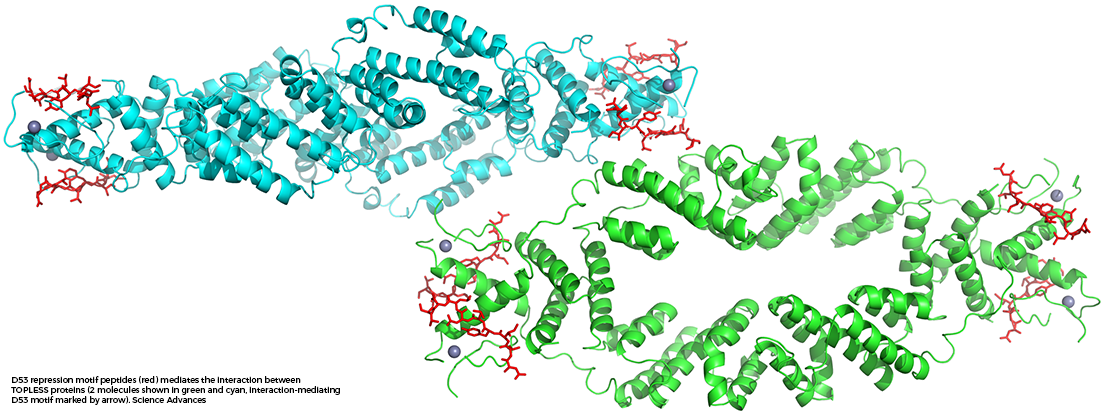Chromatin: A complex of DNA, RNA and the histone proteins. The presence of these proteins helps the DNA to condense.
Protein: As the workhorses of biology, proteins are involved in virtually every process in the body, from copying the genetic code to digestion.
Transcription: The first step in gene expression, when the DNA is copied to RNA
Transcription factor: A protein that aids in the process of transcription
Repressor: A molecule that prevents gene expression
Co-repressor: A molecule that prevents gene expression by binding to a repressor rather than to DNA directly
A protein that sometimes leads to topless plants may hold the key for better understanding how the genetic code is read and regulated in all living things, according to new findings published today in Science Advances.
This process—known as transcription—is crucial for normal, healthy function not only in plants but in all other organisms as well. When transcription goes awry, the outcome can be devastating, such as the development of cancer in humans and abnormal growth patterns in plants.
“Our findings are two-fold. On its face, this work provides a clearer picture of how plants adjust to less than optimal environments, such as a lack of nutrients. This will be critically important as a burgeoning population puts strains on the global food production system,” said Karsten Melcher, Ph.D., an associate professor at Van Andel Research Institute and a senior author of the study. “Secondly, transcription largely occurs in the same way across species. Therefore, this model gives us important insight into gene regulation in plants and humans alike.”
Regardless of species, the instructions for life are written in DNA, a winding molecule comprising sequences called genes that code for everything from eye color to risk for developing certain cancers. Each cell in the human body contains roughly six-and-a-half feet of DNA, which is tightly coiled and packaged into X-shaped structures known as chromosomes. Much like a crumpled piece of paper, DNA can only be read—and acted upon—when it is accessible, or uncoiled. This process is controlled by a cadre of molecules, including transcriptional repressors, which bind to specific genes on the DNA. These repressors then recruit other molecules called corepressors to locally mediate refolding of the DNA, restricting access until the right time or until the right signal is present.
Using X-ray crystallography, a technique that visualizes biological components, Melcher and colleagues looked at a corepressor in plants called TOPLESS, so-called because it can cause roots to grow from both the top and bottom of plants, and a transcriptional repressor called D53. They found that D53 functions as a molecular glue that sticks TOPLESS molecules to each other to more efficiently bind chromatin, a complex made up of DNA, RNA and proteins. Just like the fingers of a hand, the individual TOPLESS molecules of the stuck-together structures can likely pick up chromatin at distinct sites to pack it together. The result is a silenced gene, meaning that the instructions in the gene will not be expressed.
“Relatively little is known about how repressors and corepressors interact to silence genes,” Melcher said. “Here we’ve shown that a repressor can not only direct a corepressor to affect selected genes, but also appears to transform them into a structure that can more effectively package and silence a gene. We hope it will go a long way in helping us better understand, on a fundamental level, what occurs during gene silencing and how it may eventually be leveraged for therapeutic benefit.”
Drugs that silence genes are increasingly being investigated as treatments for cancer and neurodegenerative conditions such as Huntington’s disease. Gene silencing also is a crucial research tool for studying the genetic and epigenetic factors that contribute to a long list of conditions.
This study builds on earlier work by the team. Read more about it here.
This work was a collaboration between VARI’s Melcher, Xu and Rothbart labs and colleagues at the Chinese Academy of Sciences and Northwestern University. Authors include Melcher, H. Eric Xu, Scott Rothbart, Ting-Hai Xu, Xin Gu, Yuanzheng He, Jiyuan Ke and Honglei Ma, all from VARI; Jiyiang Li, Yonghong Wang, Hong Yu and Jingbo Duan of Chinese Academy of Sciences; and Joseph S. Brunzelle of Northwestern University. Ma, Ting-Hai Xu and H. Eric Xu also hold appointments at the VARI-Shanghai Institute for Materia Medica.
Ma H, Duan J, Ke J, He Y, Gu X, Xu TH, Yu H, Wang Y, Brunzelle JS, Jiang Y, Rothbart SB, Xu HE, Li J, Melcher K. 2017. A D53 repression motif induces oligomerization of TOPLESS copressors and promotes assembly of a corepressor-nucleosome complex. Sci Adv.
